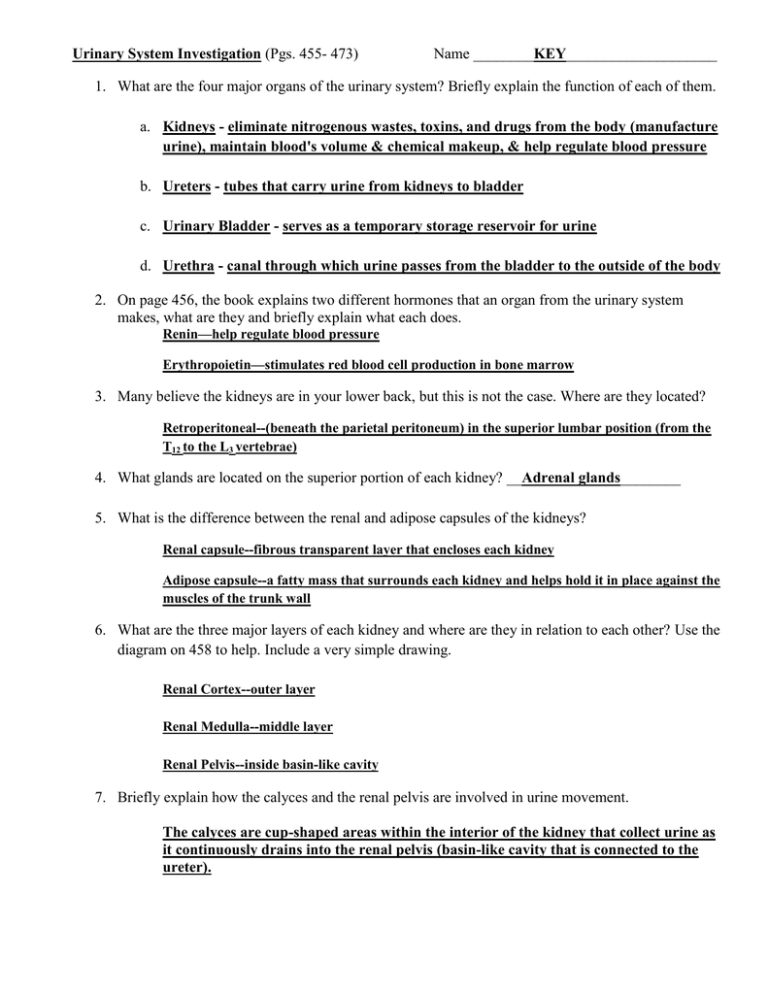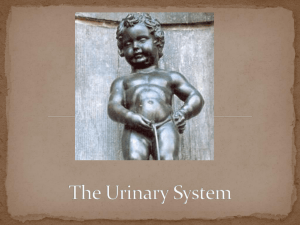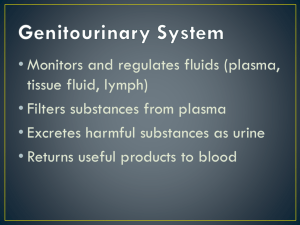Urinary System Investigation KEY
advertisement

Urinary System Investigation (Pgs. 455- 473) Name ________KEY____________________ 1. What are the four major organs of the urinary system? Briefly explain the function of each of them. a. Kidneys - eliminate nitrogenous wastes, toxins, and drugs from the body (manufacture urine), maintain blood's volume & chemical makeup, & help regulate blood pressure b. Ureters - tubes that carry urine from kidneys to bladder c. Urinary Bladder - serves as a temporary storage reservoir for urine d. Urethra - canal through which urine passes from the bladder to the outside of the body 2. On page 456, the book explains two different hormones that an organ from the urinary system makes, what are they and briefly explain what each does. Renin—help regulate blood pressure Erythropoietin—stimulates red blood cell production in bone marrow 3. Many believe the kidneys are in your lower back, but this is not the case. Where are they located? Retroperitoneal--(beneath the parietal peritoneum) in the superior lumbar position (from the T12 to the L3 vertebrae) 4. What glands are located on the superior portion of each kidney? __Adrenal glands________ 5. What is the difference between the renal and adipose capsules of the kidneys? Renal capsule--fibrous transparent layer that encloses each kidney Adipose capsule--a fatty mass that surrounds each kidney and helps hold it in place against the muscles of the trunk wall 6. What are the three major layers of each kidney and where are they in relation to each other? Use the diagram on 458 to help. Include a very simple drawing. Renal Cortex--outer layer Renal Medulla--middle layer Renal Pelvis--inside basin-like cavity 7. Briefly explain how the calyces and the renal pelvis are involved in urine movement. The calyces are cup-shaped areas within the interior of the kidney that collect urine as it continuously drains into the renal pelvis (basin-like cavity that is connected to the ureter). 8. What medical term does the book repeatedly use to indicate the kidneys or something related to them _______Renal__________________? Label the kidney diagram to the right. Terms to include: Renal Artery Renal Vein Cortex Medulla Medullary Pyramids Renal Capsule Ureter Renal Pelvis Renal Pelvis Cortex Medulla Renal Artery Renal Vein Medullary Pyramids Renal Ureter Capsule 9. What are the structural and functional units of each kidney called? _______Nephron_______ 10. What are the various structures that are part of the units mentioned in the previous question? Glomerulus, Glomerular (Bowman’s) capsule, renal tubule (proximal tubule, Loop of Henle, distal tubule) 11. Label the following letters using the diagram to the right. Do not label f and g. a. Glomerulus/Glomerular Capsule b. Efferent arteriole c. Interlobular artery d. Proximal convoluted tubule e. Loop of Henle h. Peritubular Capillaries i. Distal convuluted tubule j. Arcuate vein k. Arcuate artery l. Collecting duct 12. What are the three major steps to urine formation? a. Filtration b. Reabsorption c. Secretion 13. Explain the major points of filtration. Filtration—a nonselective, passive process in which water and solutes smaller than proteins from the blood are forced through the capillary walls and pores of the glomerular capsule into the renal tubule. 14. An abnormally low urine output between 100 mL and 400 mL per day is called Oliguria whereas a urine output of less than 100 mL per day is called Anuria. 15. Considering the answers to question 15, what do you think polyuria might mean? Polyuria = An abnormally high urine output 16. What major disorder is polyuria associated with? Diabetes 17. Explain the major points of reabsorption. Reabsorption—Useful substances, such as water, glucose, amino acids, and ions, are transported out of the filtrate into the proximal tubule cells and then enter the capillary blood (uses both passive and active transport of substances). This process changes depending on what is needed at a particular time to maintain normal pH and electrolytes in the blood. 18. Explain the major points of secretion. Secretion—Reabsorption in reverse, waste products and non-needed substances/ions, such as H+, K+, creatinine, and drugs, are removed from the peritubular blood and secreted by the distal tubule cells into the filtrate to be eliminated in the urine. This process helps with controlling blood pH. 19. What are the most important nitrogenous wastes found in blood and where does each result from? Urea—end product of protein breakdown, formed in the liver when amino acids are used to produce energy Uric acid—released when nucleic acids are metabolized Creatinine—associated with creatine breakdown in muscle tissue 20. Using the diagram on page 463, from what three major sources do we get the essential water we need to maintain homeostasis? Water Sources—Beverages (60%), Foods (30%), and Metabolism (10%) 21. From what four major sources is most of our water excreted? Routes of Water Loss—Urine (60%), Losses via skin & lungs (28%), Sweat (8%), and Feces (4%) 22. It is well known that the kidneys play a major role in the water and electrolyte balance of the blood for homeostatic reasons. However they do not work alone, what two hormones help the kidneys maintain this balance and how does each hormone contribute? Antidiuretic Hormone (ADH)—prevents excessive water loss in the urine by causing the kidney’s collecting ducts to reabsorb more water into the blood Aldosterone—regulates blood composition and blood volume by controlling sodium ion (Na+) content of the extracellular fluid which helps regulate the concentration of other ions as well (Cl-, K+, Mg2+). Causes reabsorption of sodium and water into the distal tubule and collecting ducts. 23. Explain the difference between alkalosis and acidosis. Alkalosis—condition where the pH of the arterial blood is above 7.45 Acidosis—condition where the pH of the arterial blood is below 7.35 24. Explain how blood buffers help the body prevent the two disorders in the previous question. Blood buffers prevent large changes in pH (H+ ion concentration) when strong acids or bases are introduced to the blood. Buffers contain a combination of a weak acid and a weak base that will react chemically with strong acids and bases. A weak base, such as sodium bicarbonate (NaHCO3), will bind to hydrogen ions (H+) when the pH drops (strong acid is added). A weak acid, such as carbonic acid (H2CO3), will release hydrogen ions (H+) when the pH rises (strong base is added). This process can steady the pH within a fraction of a second. 25. Using page 467, what are the two most important ways that the kidneys maintain the acid-base balance of the blood? (1) Excreting bicarbonate ions (HCO3-) (2) Conserving (reabsorbing) or generating new bicarbonate ions 26. Why is urine yellow in color? Due to the pigment urochrome that results from the body’s destruction of hemoglobin 27. Is urine acidic or basic? Usually slightly acidic (around pH 6) But can be both! Urine pH varies from 4.5 to 8.0 28. What do diuretics do? Diuretics are drugs/chemicals that increase urine output 29. What are some of the common solutes found in urine? Sodium ions (Na+), potassium ions (K+), urea, uric acid, creatinine, ammonia, bicarbonate ions (HCO3-), and various other ions depending on blood composition 30. What are renal calculi? How are they formed? Renal calculi—also known as kidney stones are uric acid salt crystals that precipitate (undissolve) in the renal pelvis and cause extreme pain as they pass out of the kidney and through the ureter. Renal calculi formation can be caused by frequent bacterial infections, urinary retention, and alkaline urine. 31. What are some of the symptoms of a urinary tract infection? Dysuria (painful urination), urinary urgency and frequency, fever, and sometimes cloudy or blood-tinged urine. (Kidney infection also includes back pain and severe headaches.) 32. What is micturition? Micturition—(also known as voiding) is the act of emptying the bladder 33. What is incontinence? Incontinence—the loss of voluntary control of the external sphincter surrounding the urethra (loss of control of urination) 34. What is urinary retention? Urinary retention—the condition in which the bladder is unable to expel its contained urine 35. Using page 469, explain what dialysis is and why a person might need to be on dialysis? Dialysis—Uses an “artificial kidney” apparatus which cleanses the blood of wastes. The blood is removed from the body temporarily and passed through a membrane tubing that is permeable only to selected substances. Wastes leave the blood inside the tubing and pass into the surrounding solution. Useful substances move from the bathing solution into the blood inside the tubing. A person would require dialysis if they are experiencing renal failure and the number of functioning nephrons becomes too low to carry out normal kidney functions 36. What is glycosuria? (Use Table 15.1) Glycosuria—urine with a high glucose (sugar) content a. What does the non-pathologic (non-disease) form result from? Excessive intake of sugary foods b. What does the pathologic (diseased) form result from? Diabetes mellitus 37. Blood found in the urine is called Hematuria. Is it normal to find blood in the urine? NO 38. If a doctor found excessive amounts of bilirubin (a bile pigment) in the urine, what might he or she suspect might be the reason? Liver disease (Hepatitis) 39. Protein is not found in the urine normally, so finding it in the urine would indicate what malady? Hypertension or Glomerulonephritis







